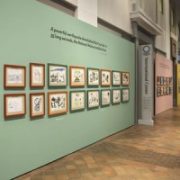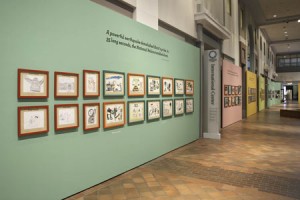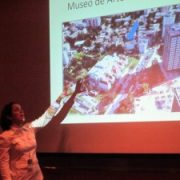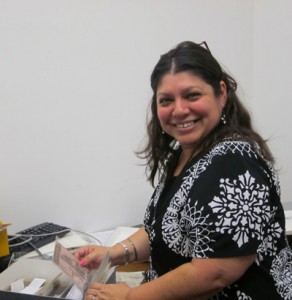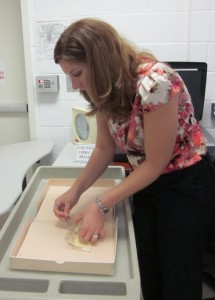An inspiring exhibition for your neighborhood
Thirty-five seconds. That’s all it took to forever change the world for millions of Haitians on January 12, 2010. Now imagine those 35 seconds from a child’s point of view.
Soon after the devastating earthquake, first lady of Haiti Elisabeth D. Préval called on Haitian artist Philippe Dodard and his fellow artists, as well as psychologists, educators and politicians, to create a safe place for children to express their feelings through art. Operating from converted buses at two sites in Port-au-Prince, Plas Timoun (The Children’s Place) uses the power of the visual and performing arts to bring healing to children, ages 6-10.
The simple works on paper created immediately following the earthquake were dark in color and imagery. Soon after, drawings began to reveal glimmers of hope and healing. The children of Plas Timoun were using brighter colors and depicting the innocence of childhood and their vision for a brighter future, attesting to the resilience of a nation and the power of art. With the help of Plas Timoun, these children will move more confidently toward their future and the lasting reconstruction of Haiti. “This exhibition gives the children of Haiti a chance to present to the world their vision of themselves and of the reconstruction of their country,” said Préval. “Their voices, so well expressed by colors and emotions, reflect our imaginary and social reality as vectors encouraging viewers to think with us of solutions to the problems facing contemporary Haiti.”
Nearly 100 paintings and drawings created by Haiti’s young people at Plas Timoun are featured in the exhibition The Healing Power of Art: Works of Art by Haitian Children after the Earthquake, organized by the National Museum of African Art. Now, Smithsonian Affiliates can be the first to host this inspiring exhibition in their own community.
While several of the artworks depict images relating to death and destruction, they also include illustrations of houses Рboth standing and damaged Рwith local architectural features, planes and helicopters reflecting rescue and recovery efforts, as well as colorful Haitian flags, nature scenes, abstract designs and children at play. Drawings by former First Lady Elisabeth Pr̩val, First Lady of the United States, Michelle Obama, and Second Lady of the United States, Jill Biden who participated in a painting session at Plas Timoun, are included.
In addition, the exhibition includes three videos: Thirty Five Long Seconds: Haiti’s Deadly Earthquake, an 18-minute film chronicling the earthquake and its aftermath written and narrated by Mario L. Delatour, and two short video segments, one in which Dodard discusses the concept behind Plas Timoun and the other on a visit to Haiti by Mrs. Obama and Dr. Biden. An outstanding beaded Haitian flag, map of Haiti and didactic panels complement the exhibition.
For more information on booking this exhibition, click here to download the exhibition prospectus.

